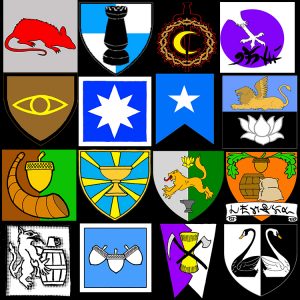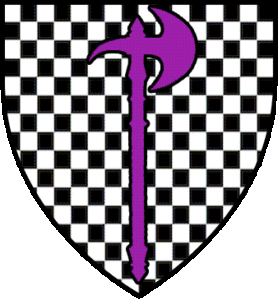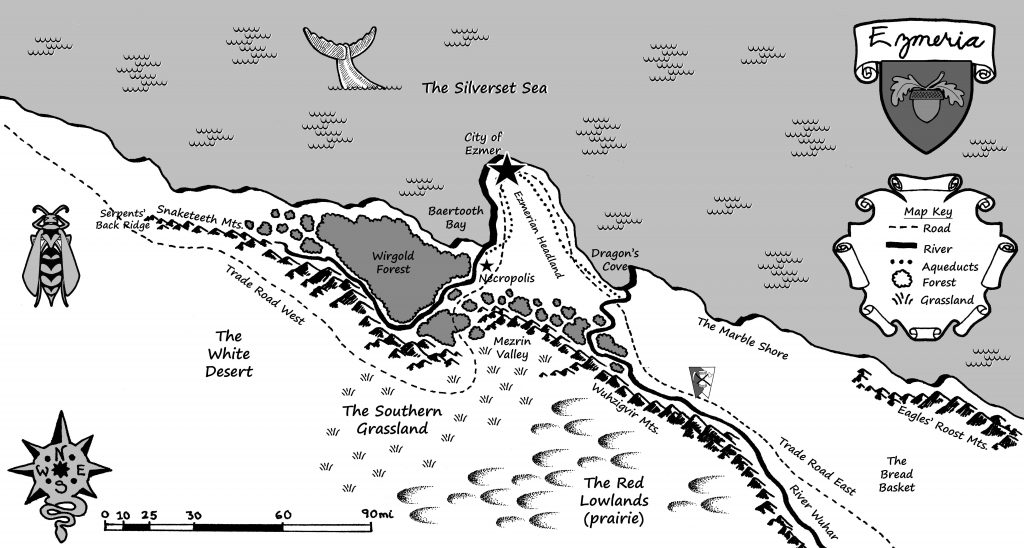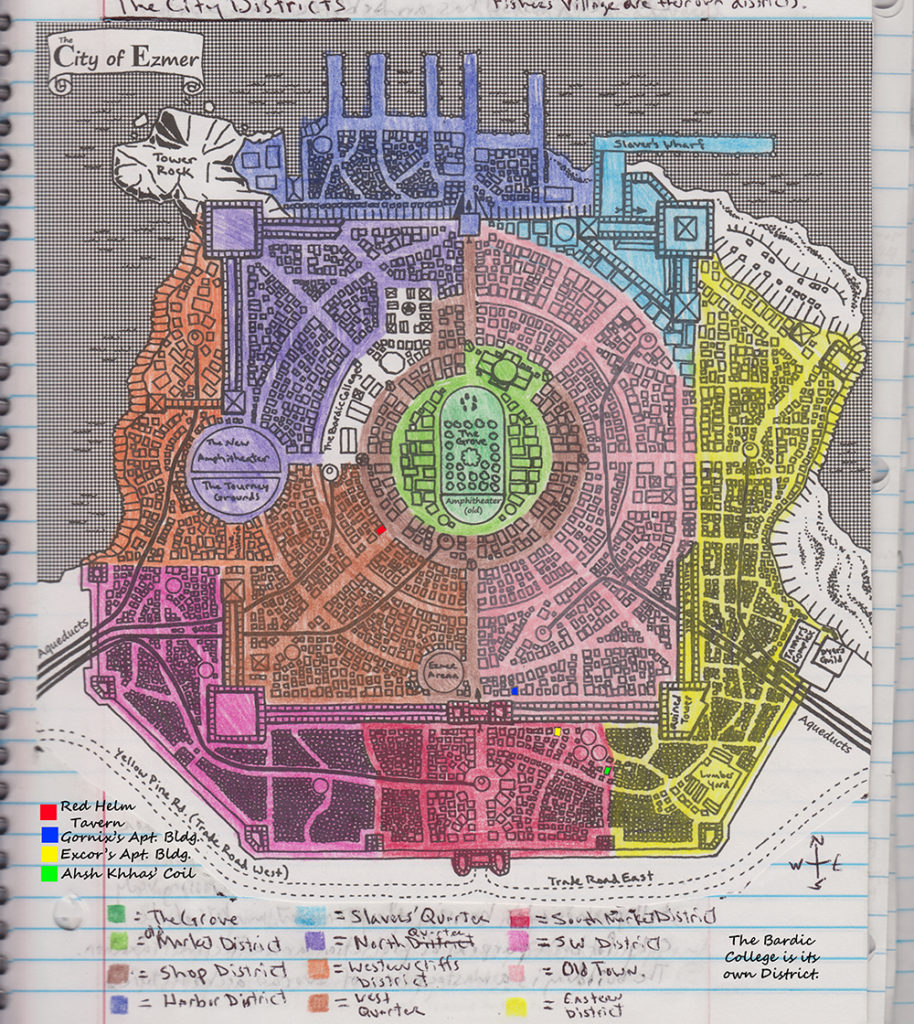Brilliant war banners, strikingly colored flags waving in the wind, and fascinatingly designed symbols on the surcoats of warriors, which sometimes strangely define the character of the individual. Heraldry is more than just a splash of color or the addition of intriguing art; it can serve a deeper purpose within a roleplaying game.
surcoats of warriors, which sometimes strangely define the character of the individual. Heraldry is more than just a splash of color or the addition of intriguing art; it can serve a deeper purpose within a roleplaying game.
Heraldic devices and symbols can be a short hand for the nature and/or attitudes of groups and organizations, which can help with NPC characterization if an individual does not fit this mold or vice versa. Player Characters may strive to either earn or adopt imagery under which they can gain prestige and earn an easily recognized reputation. I use the basics of heraldry in my games to add some color. In addition, I take care to add in certain conventions and symbols native to the game world or region for which I am creating.
There is no doubt whatever that symbolism forms an integral part of armory; in fact there is no doubt that armory itself as a whole is nothing more or less than a kind of symbolism. [Fox-Davies. 1978. A Complete Guide to Heraldry. Bonanza Books, New York. p.5]
I use Heraldry in my games because it seems to stick in the players’ heads without much effort on their part. It also provides some preliminary characterization on occasion and can communicate the symbols important to the culture of those using it adding to the world building. When Game-Mastering I use coats of arms to mark out organizations, locations such as towns and cities (seals), and individuals of note. I also use simplified versions on wax and clay seals and on signet rings, not just the colorful incarnations found on flags, shields, and surcoats.
On maps and handouts, seals and flags can help to divide a map into political regions and distinguish the factions with an easily identified visual symbol that is easily digestible and easily confirmed.
Language of Color and Symbols
In the most basic of terms heraldry is the use of color, symbols, and decoration as distinguishment of identity. It is also an art and with that it carries with it tis own language which may be different for different cultures as in Armory (concerning the art and study of armorial bearings including its legalistic side). This symbolic art language is heraldry and the primary result is the coat of arms.
When heraldry came into existence it came in as an adjunct of decoration, and it necessarily followed that the whole of the positions which the craftsmen found the eagle or the lion depicted were appropriated with the animals for heraldry. That this appropriation for the exclusive purpose of armory has been silently acquiesced in by the decorative artists of later days is simply proof of the intense power and authority which accrued later to armory, and which was in fact attached to anything relating to privilege and prerogative. [Fox-Davies. Pgs.3-4]
Arms are emblazoned on Banners, Standards, Flags, Shields (shield emblems date at least from late roman times), Surcoats, Tabards, Pennants/Pennons, Sashimono, Nobori, Uma-jirushi, Hata-jirushi. The idea of heraldry may have evolved from the preferred designs or decoration conflated with certain individuals or militaries becoming their recognized insignia.
Quick & Dirty Heraldry Primer
There are some terms that used in this discussion, which are Shield, Field, and the names of the Partitions, Charge, Helm, and Motto.
Shield – The central shape bearing the coat, which is the shape of a shield typically an escutcheon but can be round or oval especially in those cultures whose warriors’ shields are of a particular shape. It seems likely this evolved from the painting of shields or identifying marks and decorations put on the front of shields. The shield “constituted the warrior’s ‘weapon’ par excellence, the symbol of his status and function. It was handed to him when he was admitted to the ranks of warriors for the first time; to abandon it henceforth was a disgrace. If he died in combat, the warrior was carried away on his shield. During assemblies, decisions were approved by warriors striking […] their shields.” [Contamine, Phillippe. 1984. War in the Middle Ages. Basil Blackwell Publisher Limited (English Translation).Oxford, England. p.178]
Field – The Field is the background element of the arms that is usually a solid color but can be partitioned.
Partitions – The field partitioned in half, into quarters and diagonally (per bend). The line of the partition is usually not visible but designated by the difference in color between them. An example is where the right (Dexter) partition as a yellow field and the left (Sinister) as crimson.
Charge – Typically, a central emblem set at the center of the shield on the field, which can be an abstract symbol or the portrayal of an animal, human, monster, plant, fruit, flower, etc.
Helm – The position of helm is at the top center of the shield and is typically a helm with stylized and complex plumes draping from it. Like the shield, the helm is shaped and representative of its culture although instead of a helmet it can be the head of animal or beast as well as such objects as flowers or skulls.
Motto – This takes the form of a ribbon, banner, or plaque at the bottom of the shield or beneath it. This object bears a saying taken to be a core value to those the coat of arms represents i.e. a family motto.
Coat of Arms – A coat of arms is the central heraldry on the shield including the field(s) and central charge. This collection of heraldic symbols is also easy to transfer to other display formats such as banners, flags, or surcoats. The most simplistic form of a heraldic coat of arms is a charge on a field although there are examples in history of a simple single color field only.
The purpose of this system of design and bearings is essentially for identification usually associated with important individuals and families.
I.D.
Heraldry is a form of visual identification and encoded certain information so that observers could identify those bearing it and read certain specific meanings in its symbols. The most common of these would be Unit Identifiers, Origin, and Loyalties.
Unit Identifiers are heraldic marks that identify a military unit and its divisions. These can correlate to signal flags calling for and relaying simple orders to a specific unit on the field or to certain signifiers such as honoraria or special awards.
The tradition of each century in a legion having its own standard (signum) appears to have continued throughout the Principate. […]Signa appear to have been topped either by an ornamental spearhead or an upraised hand. Theiur shafts were heavily decorated with cross-pieces, wreaths, and from two to six large discs. The actual significance of any of these items is unknown, though it does seem probable that together they provided a system for identifying the particular century. [Goldsworthy, Adrian. 2003. The Complete Roman Army. Thames & Hudson Inc. New York, NY. p.134]
The central charge or another secondary charge or even specific color of field can denote from where the bearers have come. It can denote a specific region of an area all the way down to a household within that specific region using additional symbols or certain well-known components. This type of sign can also be unintentional such as when a certain color of dye is limited to a specific region so those nearest that area will make use of the color thus all those using that color are within the limits of a certain, although probably wider, area. This last idea may also give away an imposter to those with the proper knowledge and a keen eye for detail.
At the time of the third crusade (1188- 90), ‘it was agreed that all those coming from the lands of the king of France should wear red crosses, those from the lands of the king of England white, and those from the county of Flanders green crosses.’ […] In their turn the Burgundians chose an emblem – the cross of St. Andrew, either in saltire (en sautoir) or forked (fourchue), in white or red. [Contamine. p.190]
Heraldry can also exhibit loyalty to a specific individual, their administration, and/or their family by way of pictures or symbols. “When Pontius Pilate first visited Jerusalem […], an uproar was created because his escort had brought its standards, including the imagines [a series of images of the emperor and his close family which were mounted on poles and kept with the standards], with them, thus bringing graven images into the Temple and offending Jewish law.” [Goldsworthy. p.143]
On the Battlefield
Heraldry is of practical use on the battlefield in that certain types of flags and their symbols including color can carry meaning for desperate soldiers. They can also serve as signals sending complex messages long distances cutting through the noise and chaos with brightness. “[C]ommanders would have individual flags hoisted high that gave the troops something to follow across the battlefield, while signal flags gave instructions such as advance, retreat or adopt defensive positions.” [Haskew, Michael. 2008. Fighting Techniques of the Oriental World AD 1200 – 1860. St. Martin’s Press, New York, NY. p.32]
As a Rallying Point, the standard of a king or commander can serve as markers on the battlefield for their location. Back at camp flags, banners, and standards serve to mark a location for troops to rally around or a place to regroup. It can also help lead soldiers to battle especially when all else is eclipsed by the fog and clatter of war, they have the flag to follow into the fray.
Banner systems provided the most ready mechanism for giving some form of battlefield coherence. In the Japanese forces, not only did samurai carry the Nobori flag attached to the back of their armour – giving the attendant ashigaru some prominent form of bearing – but the ashigaru themselves would often transport various insignia around the battlefield. Some would carry the hata-jirushi (flag streamer), the base of the flagpole sitting in a holder fixed to the waistband. This flag would denote the nearby presence of a particular samurai. Some soldiers were esteemed enough to carry the uma-jirushi flag attached to the back of their armour, thus indicating that a general or daimyo was present. While these positions obviously carried a certain honour, they could dramatically shorten the life of the flag carrier – enemy soldiers were attracted to such insignia as they were obvious targets. [Haskew. p.32]
Signal flags can signal certain units to carry out their part of a battle plan on the field of war. They can convey simple messages such as move to the front, retreat, fire, or charge as well as slightly more complex signals such as break off and carry out a specific maneuver. This is discounting any kind of semaphore that is. Heraldic marks and partitions can be added to increase the limited vocabulary of signal flags and remain distinguishable from each other.
Traditionally a distinctive vexillum or flag, usually in red, marked out the commander’s position in camp before a battle and on the battlefield. Vexilla also provided the main standard for detachments of troops serving away from their parent unit, so that in time such detachments became known as vexillations (vexillationes). [Goldsworthy. p.134]
As a war trophy an opponent’s heraldry is unmatched, in effect the victor has stolen their identity. The seized coat of arms serves as a symbol of victory and the enemy’s defeat and remains on display as their shame. Pennants and flags displayed like trophies hung upside down, inverted, or in a certain location such as on a post are common as is the burning of captured flags, which is more an act of annihilation.
When displayed in the camp or at home base in any of the previously discussed manners this can serve to diminish the enemy to and improve morale among the troops. Displays of such trophies can also serve to increase the prestige of the one who possesses it especially if the defeated carried a reputation. When a captured flag marched in front of a unit on the field serves much the same purposes and could serve to direct the enemy’s ire at that unit as well.
Naturally the sequel to a battle entailed various religious ceremonies: the obsequies and burial of the dead according to the means dictated by circumstances or by the social status of the victims; masses for favours shown and the Te Deum celebrated by the victor, who might also offer trophies from the victory – flags, spurs, pieces of armour – to a sanctuary, found a rich abbey or a modest oratory. [Contamine. p.300]
In Game
Heraldry and its devices can be used to great advantage within a fantasy campaign. Coats of arms are cheap characterization tool (a la cliché representations of character), serve as mnemonic devices for places, people, and organizations, as well as all the previously mentioned conventional uses.
As symbolic short hand, heraldry can communicate heaps of random game info to Players and their characters. As a cheap characterization tool is relates to the old cliché of skulls and black for bad, and white and feathered wings for good or vice versa using the wolf’s in sheep’s clothing cliché. The more complex and showy a character’s coat of arms then the more powerful they are or the more of a blow-hard, perhaps both. However, heraldry can use its own language of symbols and colors to imply certain characteristics such as lineages with arcane power, necromancy, bad histories, disagreeable personalities or historically very agreeable ones unique to your game world. Heraldic symbols carry reputations with them as well as symbolizing power, heritage, or other such things within the culture and from history from which it takes its images and symbols.
Images are easier to remember especially brightly colored designs than just names even of individuals. Therefore, heraldic devices help to memorize reputations, lineages, organizations and the ranks in that organization. This is especially true in a region or world with limited literacy. In such societies, a family crest is indispensable in proving who you are by proving your relations. Heralds may keep rolls of diagramed records of coats tracking the evolution of the heraldry from person to person thus creating a sort of genealogical history of symbols.
Complimentary World Building Device
Heraldry can help a GM to build their world and link its internal elements together through association. As previously mentioned it also carries additional, honestly sometimes extraneous, information to the PCs.
Symbolic representations of a culture or group used in related individuals’ arms deepen the game world by displaying their relationship and even occasionally the nature and mood of that relationship.
[A]n additional type [of flag] had been adopted by some [Roman] cavalry units for use in parades and perhaps at other times. This was the dragon or draco, a bronze animal head with an open mouth and neck to which was attached a multi-colored tube or material. When the standard bearer moved quickly, the tube or material acted like a wind-sock, streaming behind the head and making a whistling sound. These standards seem to have been copied from some of Rome’s opponents on the Danubian frontier, most notably the nomadic Sarmatians, and are depicted on Trajan’s Column flying over the enemy armies. [Goldsworthy. p.134]
Heraldry adds in bright colors and may even allude to a deeper connection with those it represents such as the previously mentioned origin of the bearer through intention or the use of rare dyes/pigments or unusual symbols. It can act as set dressing especially useful in emphasizing the scenery of such events as tournaments, duels, negotiations, encampments etc. the bonus being this set dressing hints to the greater world outside to those who can read their symbology.
The core of the Manchu military system at the time of the conquest consisted of the pa-ch’i, or ‘Eight Banners’. When the system was set up in 1601, there were four Banners – the Yellow, White, Red and Blue –distinguished by flags of the respective colours. In 1616 four more Manchu Banners were created, using flags of the same four colours but with contrasting borders. In addition, an army carried a black silk flag, which was used as a rallying point and seems to have been regarded as sacred [.] Each Banner was divided into five jalans, or regiments, each of five nirus, or ‘arrows’. A niru had a nominal strength of 300 men. [Peers, CJ. 2006. Soldiers of the Dragon: Chinese Armies 1500 BC – AD 1840. Osprey Publishing, Midland House. Oxford, UK. pgs.230-231]
The development of symbols unique to your group incorporated into the heraldic language is a definite option that you should use. This creates unique heraldic devices that carry special meanings found only on that world. In addition, you can encode PC actions in coats of arms either as a record of lineage or permanent symbols of that PC’s legendary victories commemorated within their family crest.
The standard and pennon of Joan of Arc were not the only flags embroidered with pious images or texts; such flags can be found in almost every army of the day, Burgundian, English, Lotharingian, etc. Certain standards even had a sacred character, like the banner of St James at Compostella, that of St Lambert at Liege and the Oriflamme of St Denis. […] It is remarkable that, prolonging a usage which doubtless arose during the first crusade, crosses made out of material of different colours and shapes served from the fourteenth century as the distinctive emblems for English, French, Breton, Burgundian and Lotharingian combatants. Just as some sacred decoration was in part military, so military decoration was in part religious. [Contamine. p.298]
Conclusion
When used in a game heraldic devices and symbology can convey vast amounts of information to players at a glance and deepen the psychology of the fictional world. This is true whether that information is genealogy, reputation, origin, history, military rank, unit demarcation, or as a cliché characterization tactic. This is especially true when the GM and Players have created their own index of symbols and put thought into why someone would use these symbols as an emblem or collection thereof that serves to identify them personally and sometimes spiritually.
Using heraldry of any sort in your game adds a language of color and symbols allowing for greater communication with players through the game itself and adds a touch of realism as well as some arresting visual flair.
[do_widget id=”cool_tag_cloud-4″ title=false]



